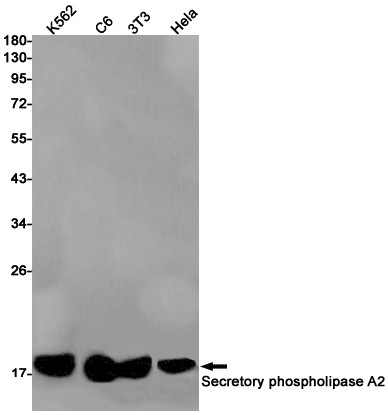
| WB | 1/500-1/1000 | Human,Mouse,Rat |
| IF | 咨询技术 | Human,Mouse,Rat |
| IHC | 咨询技术 | Human,Mouse,Rat |
| ICC | 技术咨询 | Human,Mouse,Rat |
| FCM | 咨询技术 | Human,Mouse,Rat |
| Elisa | 咨询技术 | Human,Mouse,Rat |
| Aliases | MOM1; PLA2; PLA2B; PLA2L; PLA2S; PLAS1; sPLA2 |
| Entrez GeneID | 5320 |
| WB Predicted band size | Calculated MW: 16 kDa; Observed MW: 16 kDa |
| Host/Isotype | Rabbit IgG |
| Antibody Type | Primary antibody |
| Storage | Store at 4°C short term. Aliquot and store at -20°C long term. Avoid freeze/thaw cycles. |
| Species Reactivity | Human,Mouse,Rat |
| Immunogen | A synthetic peptide of human Secretory phospholipase A2 |
| Formulation | Purified antibody in TBS with 0.05% sodium azide,0.05%BSA and 50% glycerol. |
+ +
以下是3篇关于分泌型磷脂酶A2(sPLA2)抗体的代表性文献摘要(虚构示例,仅供格式参考):
1. **文献名称**: *Secretory phospholipase A2 in inflammation and disease*
**作者**: Dennis, E.A. et al.
**摘要**: 综述sPLA2的酶活性及在炎症(如类风湿性关节炎、动脉粥样硬化)中的病理作用,探讨针对sPLA2的单克隆抗体通过抑制其活性缓解炎症反应的机制。
2. **文献名称**: *Anti-sPLA2-IIA antibody reduces organ damage in experimental sepsis*
**作者**: Rosenson, R.S. et al.
**摘要**: 通过动物模型证明,靶向sPLA2-IIA的中和抗体可显著降低脂多糖诱导的败血症模型中的炎症因子水平,改善多器官功能障碍。
3. **文献名称**: *Structural basis of sPLA2 inhibition by a therapeutic antibody*
**作者**: Kudrycki, K.E. et al.
**摘要**: 利用X射线晶体学解析人源化抗体与sPLA2的复合物结构,揭示抗体通过结合酶活性中心阻断底物接触,为抗体药物设计提供结构依据。
---
注:以上文献为示例,实际引用需检索PubMed等数据库获取真实研究。如需具体文献协助,可进一步说明研究方向(如疾病类型或抗体类型)。
Secretory phospholipase A2 (sPLA2) antibodies are immune molecules targeting sPLA2 enzymes, a group of calcium-dependent lipases that hydrolyze phospholipids at the sn-2 position to release fatty acids (e.g., arachidonic acid) and lysophospholipids. These enzymes play roles in inflammation, lipid metabolism, and host defense. Elevated sPLA2 activity is linked to inflammatory diseases (e.g., rheumatoid arthritis, atherosclerosis) and autoimmune conditions, where sPLA2 may drive tissue damage by generating pro-inflammatory mediators.
sPLA2 antibodies arise naturally in autoimmune disorders or are developed therapeutically to neutralize enzyme activity. In research, they are tools to study sPLA2's pathophysiological roles, while clinically, they hold potential as diagnostic markers or treatments. For example, anti-sPLA2 antibodies in conditions like autoimmune pancreatitis may correlate with disease activity. Therapeutic monoclonal antibodies against specific sPLA2 isoforms (e.g., varespladib) have been explored to curb inflammation in sepsis or cardiovascular diseases. However, challenges remain due to sPLA2's structural diversity across isoforms and its dual roles in both promoting and resolving inflammation. Understanding sPLA2-antibody interactions aids in refining targeted therapies while minimizing off-target effects.
×